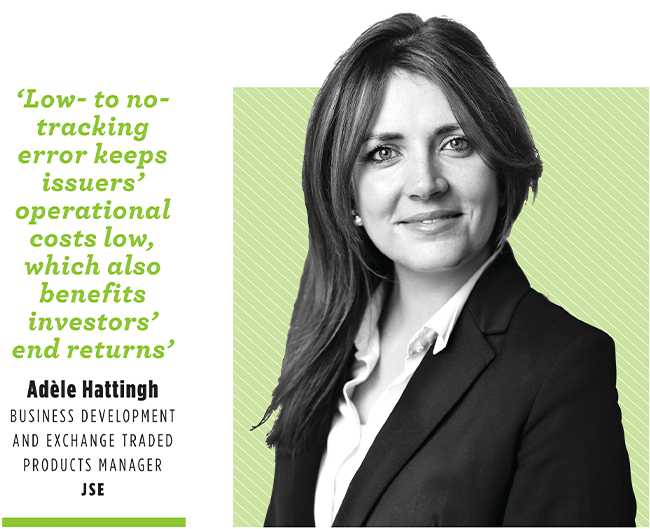When FNB recently mass-listed big-brand single-stock exchange traded notes (ETNs), it shone a new spotlight on them, and it’s easy to understand the appeal. Unlike an ETF, which tracks the performance of an index consisting of underlying assets such as shares, debt or a single commodity, an ETN can track underlying assets that are traditionally difficult for investors to gain access to or are not permitted under the JSE ETF listing requirements.
While this may seem a subtle distinction, there are many other reasons why ETNs are gaining in popularity, as explained by Adèle Hattingh, JSE: Business Development and Exchange Traded Products (ETPs) Manager. ‘There is value investing in both ETFs and ETNs, but it is important to stress the differences. An ETF holds the actual underlying assets that are ringfenced from the issuer, meaning that if something was to happen to the ETF issuer, the ETF would remain intact. It is important that the underlying assets being tracked are sufficiently liquid and, according to the JSE’s listing requirements, may not be derivative instruments. In large transaction sizes, investors may be able to exchange their ETF for the assets that are being tracked, such as the exchange of a Top 40 ETF for the actual Top 40 shares in its various proportions.

‘An ETN, on the other hand, does not allow an exchange for the assets being tracked. Due to this instrument being debt in nature and issued by a bank, investors take on the credit risk of the bank. So if that bank was to become obsolete, the investor would be exposed to the possibility of losing the investment. This, however, is absolutely not a negative; the flexibility of an ETN means that there is more exposure to underlying assets that typically are very difficult or expensive to invest in.’
Currently the JSE has 65 different ETNs listed, tracking indices – such as the FTSE/JSE Top 40 and FTSE/JSE SWIX 40 – and some are referencing single stocks, for example, Amazon, Apple, Facebook and Netflix. ‘ETN investors also have the option to gain exposure to commodities via commodity futures like corn, wheat, copper and oil. The actively managed certificate ETNs also offer investors exposure to the outperformance of local or global stock portfolios, which can include property stocks,’ says Hattingh.
ETNs typically have a five-year maturity with the option to the issuer to roll over that tenor for another five. Hattingh explains that in the 10 years since ETNs were introduced, listed ETNs have matured and delisted, others have rolled over, and some will only mature in 2042. ‘At maturity the ETN pays the full value of the investment, less management fees. However, investors are not bound to keep their investment until maturity, and may choose to buy and sell when they need to.’
Last year, 40 new ETNs listed on the JSE, with a total market cap at end-December of close to R14 billion, and more than R5.8 billion in value was traded, which is nearly four times what was traded during 2019, according to Hattingh. ‘Low- to no-tracking error keeps issuers’ operational costs low, which also benefits investors’ end returns. And even small amounts can be invested, allowing for monthly debit orders or lump-sum investment.
‘A further appeal is that securities transfer tax is not levied on an ETN,’ she says. ‘However, tax professionals should be consulted to understand impacts applicable to income or capital gains tax.’








